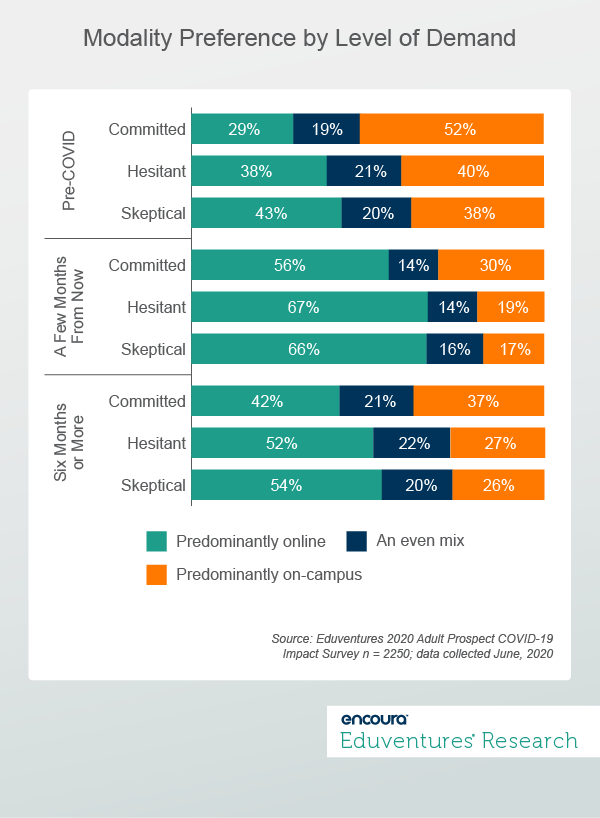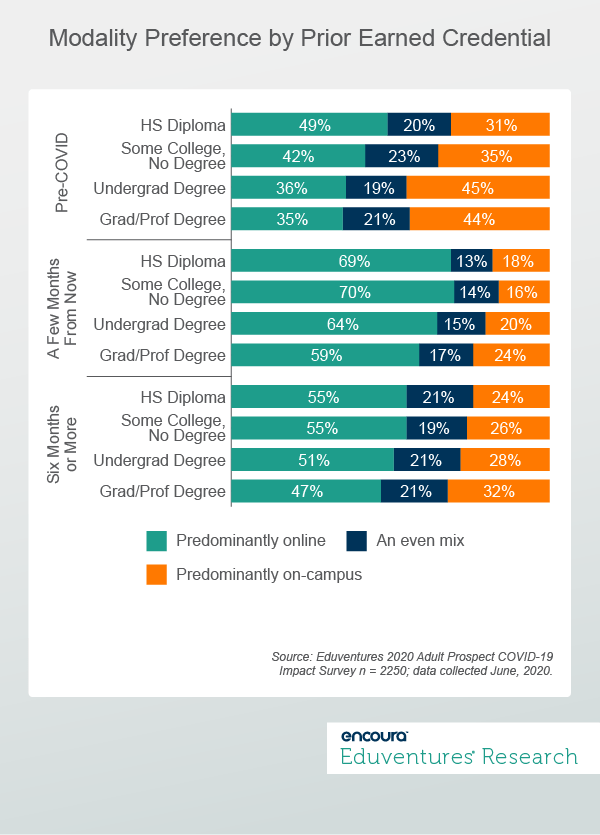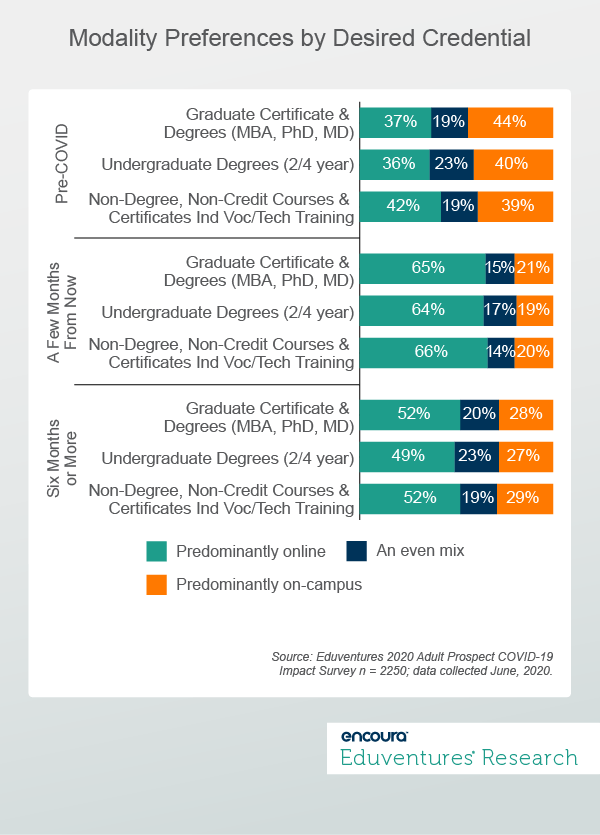2020 will long be remembered as the year of learning differently. Whether you’re enrolled in first grade or graduate school, online learning has become an unavoidable fact of life.
Eduventures’ most recent Adult Learner Research, however, reveals varying levels of enthusiasm for this new reality. While many prospects have embraced online learning in the short-term, others hold out for face-to-face school to return.
So, which adults are rooting the loudest for the online pivot, and why? And who’s holding out for a return to campus? How will these preferences shape the future of post-pandemic adult learning? Our Adult Prospect COVID-19 Impact Survey sheds light on these questions.
Growing Excitement for Online Learning
Eduventures’ adult learner research has long shown a consistent lack of enthusiasm for wholly online learning, despite online enrollment gains. The pre-COVID 2019 Adult Prospect Survey™ indicated that less than 25% of adult prospects would prefer wholly online programs. Only 5% believed that online learning was superior to an on-campus modality, and 66% reported that their enrollments would be contingent on having access to a nearby campus.
Not exactly a ringing endorsement.
But COVID-19 has changed this equation. Eduventures’ most recent adult research strongly indicates that public health concerns and the burdens of caring for family members—and in many cases educating their own children—are forcing these prospects to .
In June 2020, we asked adult prospects to identify their preferred learning modalities at three specific points in time: “pre-COVID-19,” “a few months from now,” and “six months or more from now.” Across all respondents, 22% reported that pre-COVID, they preferred “all courses online,” echoing our earlier findings. The proportion of respondents preferring “all courses online,” however, sharply increased to 43% in the “few months from now” time period. Notably, preferences for 100% online learning declined in the “six months or more” time period to 28%--a sharp decline perhaps, but still notably higher than pre-COVID-19 trends.
One factor is the level of interest a prospect has for a postsecondary credential. Eduventures has identified three broad levels of demand, based on how respondents answer an initial screening question about interest in returning to school (percentages indicate frequency in 2020 survey responses):
- “Committed” prospects (16%): would “definitely or probably” enroll within 36 months
- “Hesitant” prospects (39%): would be “extremely or very interested" in enrolling if time and money were no object
- “Skeptical” prospects (45%): would be “somewhat or slightly interested" in enrolling if time and money were no object
To help identify key trends, preferences for a modality other than hybrid (i.e., “an even mix between on-campus and online course”) are categorized to include the following responses:
- Predominately online = “all courses online” plus “most courses online, some on-campus”
- Predominately on-campus = “all courses on-campus” plus “most on-campus; some online”
Here’s how these levels of interest align with attitudes toward online learning before, during (“a few months from now”), and post-pandemic (“six months or more from now”). See Figure 1.

Across interest levels, modality preferences follow a common pattern: pre-COVID preferences for on-campus learning give way to a preference for online learning mid-pandemic. While interest in online recedes in the “six months or more” timeframe, it remains an average of 13% higher than pre-pandemic levels.
“Committed” prospects, however, who were least likely to have favored online learning options pre-pandemic, are also the least interested in online across all time periods. Only 42% express a preference for online post-pandemic, vs. a majority of their less committed peers (52% Hesitant and 54% Skeptical). “Committed” prospects are least numerous (only 16% of our sample), but most likely to enroll.
This may reflect a greater sense of familiarity with the demands of postsecondary on-campus learning—i.e., “committed” prospects may be more informed prospects. An analysis of modality preferences through the lens of prior earned credentials sheds light on potential reasons why (Figure 2).

This shows that prospects with less postsecondary experience (high school diploma only or some college no degree) express greater interest in wholly or mostly online learning across all three time periods: before, during, and post-COVID. A campus experience may not offer the same flexibility that an online or blended modality can provide. Another explanation is that the idea of online learning dazzles less experienced adults, and the reality of relative isolation and extra self-motivation is only apparent post-enrollment. This is consistent with the online as “easy” myth, and with historical Eduventures data.
These preferences could pose challenges for both these prospects and the schools hoping to support them. A prolonged pivot to predominately online learning will place significant demands on learners with the least postsecondary experience. Their need for academic support services may test schools in new ways in a predominantly online format. Schools should also be cautious about online enthusiasm among less committed prospects in the first place.
In addition to levels of interest and the influence of prior credentials, schools should also assess possible connections between modality preferences and which credential a prospect might pursue. Figure 3 explores this relationship.

While preferences for predominately online learning look higher across-the-board, the graduate-level demand undergoes the greatest transformation. Graduate-level prospects, a minority of whom preferred online pre-COVID, are more likely to welcome predominately online learning in both the short and long-term (52% in six months or more vs. 37% pre-COVID). A majority of those seeking non-degree courses and certificates or vocational or technical training also see themselves preferring online over the longer timeframe.
The Online Bottom Line
Will your school be ready for post-pandemic adult learning? For starters, schools must recognize the differences among adult prospects in their attitudes about fully online learning. These insights can be converted into differentiated services and opportunities for distinct types of adult learners.
While learners with limited postsecondary experience may welcome an online pivot, they will need dedicated technical and academic support services, including ubiquitous Wi-Fi access, to ensure success online. Schools need to avoid the assumption that going online for these prospects will be a “plug and play” scenario.
For a greater proportion of “Committed” prospects, however, the campus retains appeal.
Beyond responding to such differences, post-pandemic institutions should also be ready to recast blended learning as something more than an in-between modality preference. Expertise in designing and delivering exemplary blended learning may finally become something schools can build upon. The sustained combination of lukewarm adult enthusiasm for online and surging online enrollment suggests that a creative blend of online and on-campus is what many prospects are really looking for.
A more in-depth report on our 2020 Adult Prospect Survey (APS) data will appear later in the year. A second APS survey to gauge shifting preferences in this atypical year will launch this fall.
Never Miss Your Wake-Up Call
Learn more about our team of expert research analysts here.
Eduventures Principal Analyst at Encoura
Contact
Thursday, October 8, 2020 at 2PM ET/1PM CT
While there’s little doubt that COVID-19 has upended conventional postsecondary wisdom, there’s less clarity over what will happen in 2021. Amid these uncertainties, is your strategy for boosting graduate enrollment ready and in place?
This webinar features the most recent data from Eduventures on prospective adult learners’ attitudes toward graduate enrollment, coupled with a deep dive into how ACT | NRCCUA’s Digital Solutions converts these research insights into effective and impactful enrollment campaigns.
Join us for a timely and not-to-be-missed discussion of how research and digital media can sharpen your graduate enrollment strategy.

